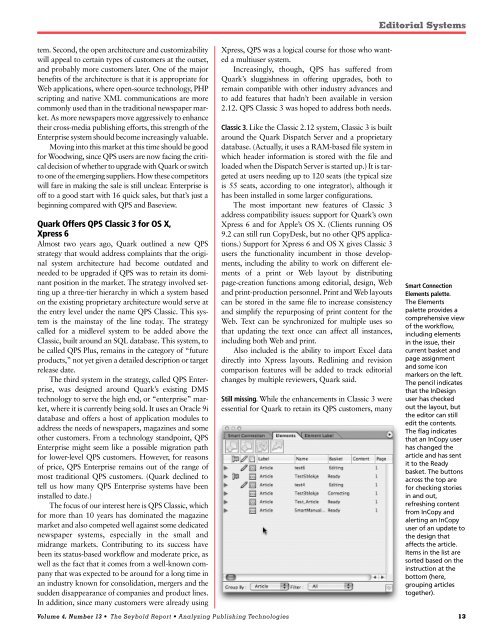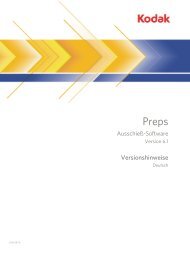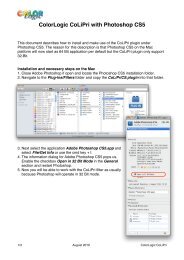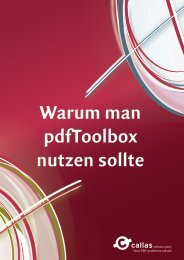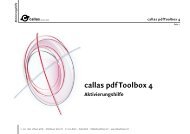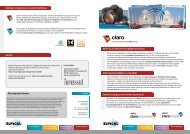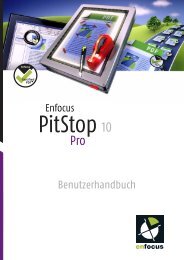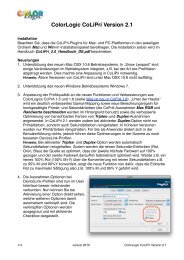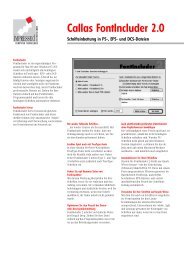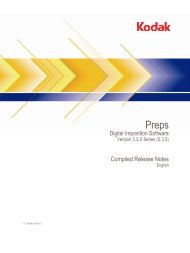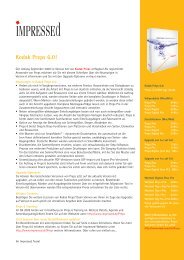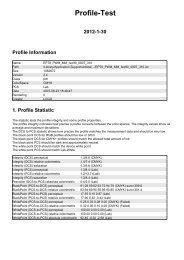New Contenders in the Editorial Systems Market - Impressed
New Contenders in the Editorial Systems Market - Impressed
New Contenders in the Editorial Systems Market - Impressed
You also want an ePaper? Increase the reach of your titles
YUMPU automatically turns print PDFs into web optimized ePapers that Google loves.
tem. Second, <strong>the</strong> open architecture and customizability<br />
will appeal to certa<strong>in</strong> types of customers at <strong>the</strong> outset,<br />
and probably more customers later. One of <strong>the</strong> major<br />
benefits of <strong>the</strong> architecture is that it is appropriate for<br />
Web applications, where open-source technology, PHP<br />
script<strong>in</strong>g and native XML communications are more<br />
commonly used than <strong>in</strong> <strong>the</strong> traditional newspaper market.<br />
As more newspapers move aggressively to enhance<br />
<strong>the</strong>ir cross-media publish<strong>in</strong>g efforts, this strength of <strong>the</strong><br />
Enterprise system should become <strong>in</strong>creas<strong>in</strong>gly valuable.<br />
Mov<strong>in</strong>g <strong>in</strong>to this market at this time should be good<br />
for Woodw<strong>in</strong>g, s<strong>in</strong>ce QPS users are now fac<strong>in</strong>g <strong>the</strong> critical<br />
decision of whe<strong>the</strong>r to upgrade with Quark or switch<br />
to one of <strong>the</strong> emerg<strong>in</strong>g suppliers. How <strong>the</strong>se competitors<br />
will fare <strong>in</strong> mak<strong>in</strong>g <strong>the</strong> sale is still unclear. Enterprise is<br />
off to a good start with 16 quick sales, but that’s just a<br />
beg<strong>in</strong>n<strong>in</strong>g compared with QPS and Baseview.<br />
Quark Offers QPS Classic 3 for OS X,<br />
Xpress 6<br />
Almost two years ago, Quark outl<strong>in</strong>ed a new QPS<br />
strategy that would address compla<strong>in</strong>ts that <strong>the</strong> orig<strong>in</strong>al<br />
system architecture had become outdated and<br />
needed to be upgraded if QPS was to reta<strong>in</strong> its dom<strong>in</strong>ant<br />
position <strong>in</strong> <strong>the</strong> market. The strategy <strong>in</strong>volved sett<strong>in</strong>g<br />
up a three-tier hierarchy <strong>in</strong> which a system based<br />
on <strong>the</strong> exist<strong>in</strong>g proprietary architecture would serve at<br />
<strong>the</strong> entry level under <strong>the</strong> name QPS Classic. This system<br />
is <strong>the</strong> ma<strong>in</strong>stay of <strong>the</strong> l<strong>in</strong>e today. The strategy<br />
called for a midlevel system to be added above <strong>the</strong><br />
Classic, built around an SQL database. This system, to<br />
be called QPS Plus, rema<strong>in</strong>s <strong>in</strong> <strong>the</strong> category of “future<br />
products,” not yet given a detailed description or target<br />
release date.<br />
The third system <strong>in</strong> <strong>the</strong> strategy, called QPS Enterprise,<br />
was designed around Quark’s exist<strong>in</strong>g DMS<br />
technology to serve <strong>the</strong> high end, or “enterprise” market,<br />
where it is currently be<strong>in</strong>g sold. It uses an Oracle 9i<br />
database and offers a host of application modules to<br />
address <strong>the</strong> needs of newspapers, magaz<strong>in</strong>es and some<br />
o<strong>the</strong>r customers. From a technology standpo<strong>in</strong>t, QPS<br />
Enterprise might seem like a possible migration path<br />
for lower-level QPS customers. However, for reasons<br />
of price, QPS Enterprise rema<strong>in</strong>s out of <strong>the</strong> range of<br />
most traditional QPS customers. (Quark decl<strong>in</strong>ed to<br />
tell us how many QPS Enterprise systems have been<br />
<strong>in</strong>stalled to date.)<br />
The focus of our <strong>in</strong>terest here is QPS Classic, which<br />
for more than 10 years has dom<strong>in</strong>ated <strong>the</strong> magaz<strong>in</strong>e<br />
market and also competed well aga<strong>in</strong>st some dedicated<br />
newspaper systems, especially <strong>in</strong> <strong>the</strong> small and<br />
midrange markets. Contribut<strong>in</strong>g to its success have<br />
been its status-based workflow and moderate price, as<br />
well as <strong>the</strong> fact that it comes from a well-known company<br />
that was expected to be around for a long time <strong>in</strong><br />
an <strong>in</strong>dustry known for consolidation, mergers and <strong>the</strong><br />
sudden disappearance of companies and product l<strong>in</strong>es.<br />
In addition, s<strong>in</strong>ce many customers were already us<strong>in</strong>g<br />
Xpress, QPS was a logical course for those who wanted<br />
a multiuser system.<br />
Increas<strong>in</strong>gly, though, QPS has suffered from<br />
Quark’s sluggishness <strong>in</strong> offer<strong>in</strong>g upgrades, both to<br />
rema<strong>in</strong> compatible with o<strong>the</strong>r <strong>in</strong>dustry advances and<br />
to add features that hadn’t been available <strong>in</strong> version<br />
2.12. QPS Classic 3 was hoped to address both needs.<br />
Classic 3. Like <strong>the</strong> Classic 2.12 system, Classic 3 is built<br />
around <strong>the</strong> Quark Dispatch Server and a proprietary<br />
database. (Actually, it uses a RAM-based file system <strong>in</strong><br />
which header <strong>in</strong>formation is stored with <strong>the</strong> file and<br />
loaded when <strong>the</strong> Dispatch Server is started up.) It is targeted<br />
at users need<strong>in</strong>g up to 120 seats (<strong>the</strong> typical size<br />
is 55 seats, accord<strong>in</strong>g to one <strong>in</strong>tegrator), although it<br />
has been <strong>in</strong>stalled <strong>in</strong> some larger configurations.<br />
The most important new features of Classic 3<br />
address compatibility issues: support for Quark’s own<br />
Xpress 6 and for Apple’s OS X. (Clients runn<strong>in</strong>g OS<br />
9.2 can still run CopyDesk, but no o<strong>the</strong>r QPS applications.)<br />
Support for Xpress 6 and OS X gives Classic 3<br />
users <strong>the</strong> functionality <strong>in</strong>cumbent <strong>in</strong> those developments,<br />
<strong>in</strong>clud<strong>in</strong>g <strong>the</strong> ability to work on different elements<br />
of a pr<strong>in</strong>t or Web layout by distribut<strong>in</strong>g<br />
page-creation functions among editorial, design, Web<br />
and pr<strong>in</strong>t-production personnel. Pr<strong>in</strong>t and Web layouts<br />
can be stored <strong>in</strong> <strong>the</strong> same file to <strong>in</strong>crease consistency<br />
and simplify <strong>the</strong> repurpos<strong>in</strong>g of pr<strong>in</strong>t content for <strong>the</strong><br />
Web. Text can be synchronized for multiple uses so<br />
that updat<strong>in</strong>g <strong>the</strong> text once can affect all <strong>in</strong>stances,<br />
<strong>in</strong>clud<strong>in</strong>g both Web and pr<strong>in</strong>t.<br />
Also <strong>in</strong>cluded is <strong>the</strong> ability to import Excel data<br />
directly <strong>in</strong>to Xpress layouts. Redl<strong>in</strong><strong>in</strong>g and revision<br />
comparison features will be added to track editorial<br />
changes by multiple reviewers, Quark said.<br />
Still miss<strong>in</strong>g. While <strong>the</strong> enhancements <strong>in</strong> Classic 3 were<br />
essential for Quark to reta<strong>in</strong> its QPS customers, many<br />
<strong>Editorial</strong> <strong>Systems</strong><br />
Smart Connection<br />
Elements palette.<br />
The Elements<br />
palette provides a<br />
comprehensive view<br />
of <strong>the</strong> workflow,<br />
<strong>in</strong>clud<strong>in</strong>g elements<br />
<strong>in</strong> <strong>the</strong> issue, <strong>the</strong>ir<br />
current basket and<br />
page assignment<br />
and some icon<br />
markers on <strong>the</strong> left.<br />
The pencil <strong>in</strong>dicates<br />
that <strong>the</strong> InDesign<br />
user has checked<br />
out <strong>the</strong> layout, but<br />
<strong>the</strong> editor can still<br />
edit <strong>the</strong> contents.<br />
The flag <strong>in</strong>dicates<br />
that an InCopy user<br />
has changed <strong>the</strong><br />
article and has sent<br />
it to <strong>the</strong> Ready<br />
basket. The buttons<br />
across <strong>the</strong> top are<br />
for check<strong>in</strong>g stories<br />
<strong>in</strong> and out,<br />
refresh<strong>in</strong>g content<br />
from InCopy and<br />
alert<strong>in</strong>g an InCopy<br />
user of an update to<br />
<strong>the</strong> design that<br />
affects <strong>the</strong> article.<br />
Items <strong>in</strong> <strong>the</strong> list are<br />
sorted based on <strong>the</strong><br />
<strong>in</strong>struction at <strong>the</strong><br />
bottom (here,<br />
group<strong>in</strong>g articles<br />
toge<strong>the</strong>r).<br />
Volume 4, Number 13 • The Seybold Report • Analyz<strong>in</strong>g Publish<strong>in</strong>g Technologies 13


